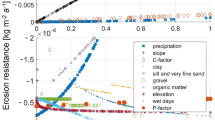Abstract
Resource economists involved in regional analysis of supply and demand relationships are concerned with the cost, reliability, and relevance of alternative levels of data detail. While analyses based on much data detail and model complexity may avoid many of the model specification and data measurement errors found in less detailed, aggregate approaches, they are relatively costly and time-consuming. Unfortunately, error is also incurred when detailed data are aggregated for analytical purposes. In this case study, a linear programming model designed to analyze an area's agricultural production potential is constructed and run at three different levels of soils detail. Policy implications of model solutions at each level of detail and trade-offs between error levels, study costs, and needs of planning officials are discussed. It is concluded that the proper level of detail ultimately depends upon the shape of the users' demand function for information.
Similar content being viewed by others
References
Bonnen, James T. “Improving Information on Agriculture and Rural Life,”American Journal of Agricultural Economics 57:5 (December 1975), pp. 753–63.
Bullock, J. Bruce, “Social Costs Caused by Errors in Agricultural Production Forecast,”American Journal of Agricultural Economics 58:1 (February 1976), pp. 76–80.
—, “Some Concepts for Measuring the Economic Value of Rural Data,”American Journal of Agricultural Economics 63:2 (May 1981), pp. 346–52.
Chappelle, Daniel E., “How Much is Information Worth?”: inProceedings: Resource Data Management Symposium, edited by John, Moser Jr., Purdue University, West Lafayette, Indiana, 1976.
Dunn, Edgar S. Jr.,Social Information Processing and Statistical Systems-Change and Reform, New York: John Wiley and Sons, 1974.
Eisgruber, L. M., “Developments in the Economic Theory of Information,”American Journal of Agricultural Economics, 60:5 (December 1978), pp. 901–05.
Hayami, Yujiro and Willis, Peterson, “Social Returns to Public Information Services: Statistical Reporting of U.S. Farm Commodities,”American Economic Review, 62:1 (March 1972), pp. 119–130.
Johnson, Glenn L., “Contributions of Economists to a Rational-decision-making Process in the Field of Agricultural Policy,” inPapers and Reports of the Sixteenth International Conference of Agricultural Economists, Oxford Agricultural Economics Institute, University of Oxford, England, 1977.
Miller, Thomas A., “Some Concepts for Measuring the Economic Value of Rural Data: Discussion,”American Journal of Agricultural Economics, 63:2 (May 1981), pp. 363–4.
Organizacion de Estados Americanos, “Plan de Accion para el Desarrollo Regional de la Linea Noroeste,” Washington, D.C., Organization of American States, 1977.
Sutton, John D., “Impacts of Aggregation Error on an Agricultural Information System,” Unpublished Ph.D. Dissertation, Michigan State University, East Lansing, Michigan, 1981.
U.N. Food and Agricultural Organization, “Diversificacion y Aumento de la Produccion Agricola en el Valle delCibao, Informe Tecnico 22: Estudios de Perspectivas de Desarrollo Agropecuaua,” Santiago, Dominican Republic, 1974.
U.N. Food and Agricultural Organization, “Diversificacion y Aumento de la Produccion Agricola en el Valle del Cibao, Informe Technico, 6: Mapas Semi-Detallados y Aptitud de los Suelos del Valle del Cibao,” Santiago Dominican Republic, 1974.
U.S. Department of Agriculture, “Soil Taxonomy,” Agricultural Handbook 436, Washington, D.C.: Soil Conservation Service, June, 1975.
U.S. Department of Agriculture and Michigan State University, “Resource Planning Units Map of the Dominican Republic,” Comprehensive Resource Inventory and Evaluation System Project, East Lansing, Michigan, 1979.
Author information
Authors and Affiliations
Additional information
The author wishes to acknowledge support of the U.S. Agency for International Development and U.S. Department of Agriculture. Thanks go to Daniel Chappelle, Department of Resource Development, Michigan State University.
Rights and permissions
About this article
Cite this article
Sutton, J.D. Policy implications of alternative levels of soil detail for economic analysis of agricultural production potential in the Dominican Republic. Ann Reg Sci 17, 57–66 (1983). https://doi.org/10.1007/BF01287472
Received:
Revised:
Issue Date:
DOI: https://doi.org/10.1007/BF01287472




